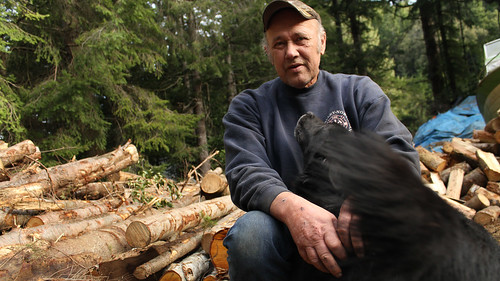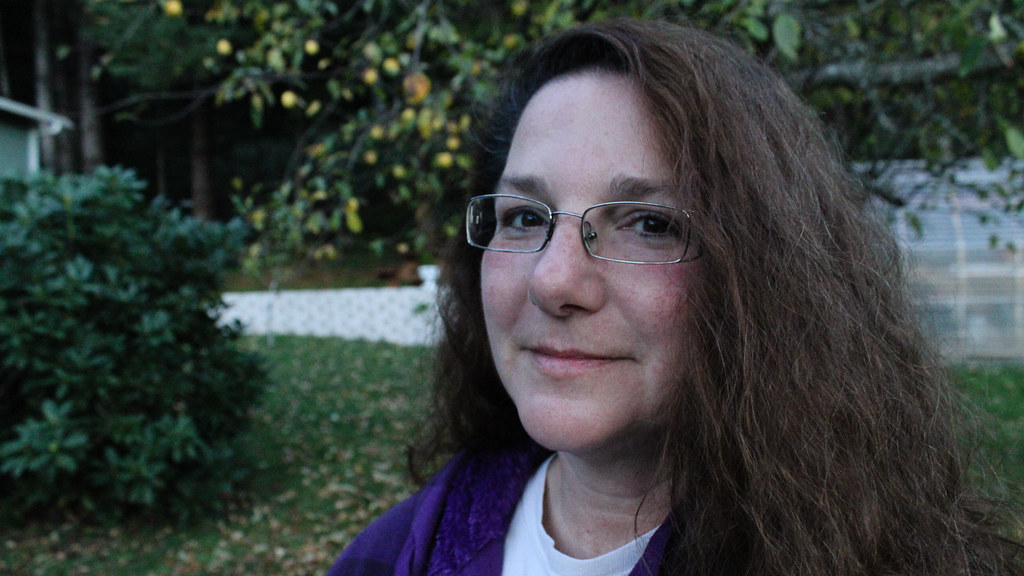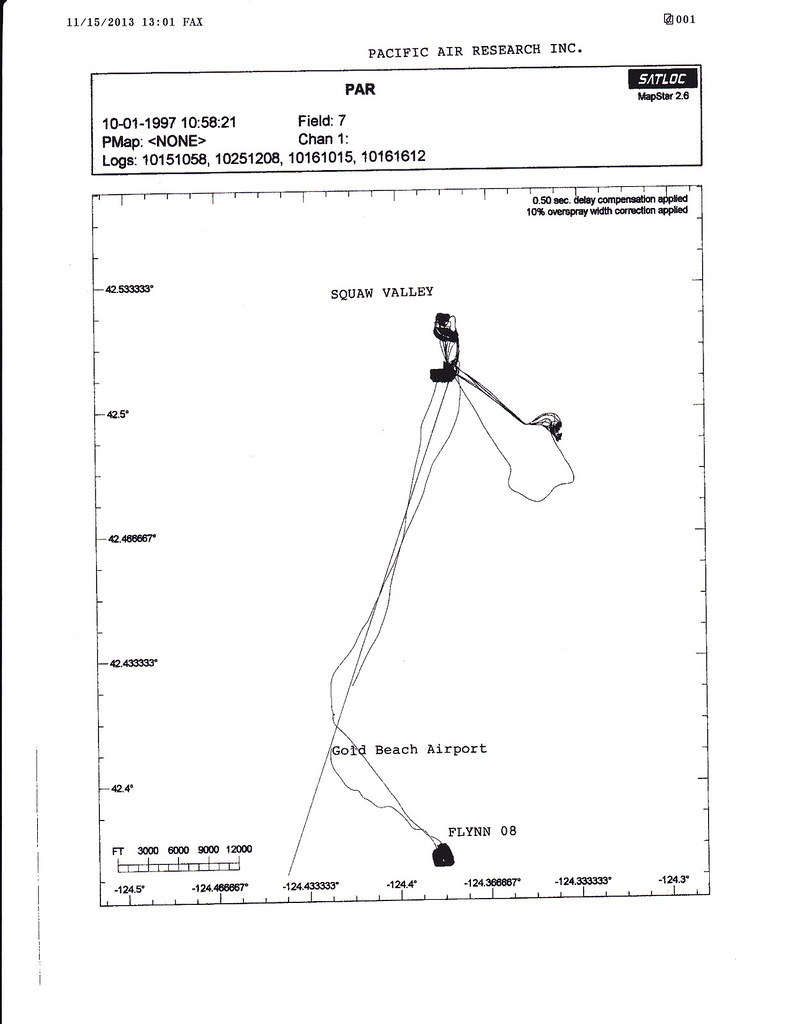
The yellow helicopter belonging to Steve Owen of Pacific Air Research was at the center of an investigation into alleged overspray during an aerial herbicide application onto forestland in Curry County.
Oregon Department of Agriculture
Steve Owen should not have been ferrying gallons of herbicides by helicopter over homes near Gold Beach, Ore.
But when John Burns glanced up from his pruning he saw the tail of Owen's helicopter high overhead. Neighbor Keith Wright noticed it dip between two trees as he tinkered with his fire department’s Humvee. A slight vibration and hum filled the room in Kathyrn Rickard’s home where she sat, studying.
The National Guard was out looking for pot farms, they each thought — not an uncommon or alarming sight in southwestern Oregon.
Then came the smell.
“Sweet, tangy kind of smell to it. Almost like a two-stroke gasoline smell,” said Beau Hanson, a 26-year-old meat cutter. “Sweet. Not like sting-your-nostrils, but it definitely was a very unique smell I have never smelled before. I could almost taste it.”
It came as Hanson was outside chopping dead cedar into firewood with his wife Lilly and their 8-month-old daughter Ada nearby.
The Hansons hurried inside and minutes later Beau was battling just the second asthma attack of his life. He puffed his inhaler to no effect. His daughter’s hands swelled. Her eyes turned red and puffy. It was for her sake that Hanson moved back to Cedar Valley, a rural community near Gold Beach. He was soon convinced the helicopter was to blame.
“At that point,” he said, “I got angry that something was going on.”
State’s critics say pilot was a scapegoat
Six months later, the findings of a state investigation offered few answers for the Hansons and nearly 40 other residents who claim the aerial spraying had made them sick.
Herbicides did fall onto some houses in Cedar Valley on that October day in 2013.
Those chemicals weren't intended for residential property. They were meant to kill vegetation on nearby industrial forestland that had recently been logged. It's a common practice in the Northwest, where alder trees, Scotch broom and blackberry brambles can outcompete newly planted fir tree seedlings if they're allowed to take root.
How the herbicides fell on homes, investigators didn’t know.
Whether that caused residents’ symptoms, they couldn’t say.
Those who complained fell into a system that, by design, triggers investigations incapable of providing answers like whether complainants were actually exposed to pesticides or how, and at what levels, interviews and documents show.
THE PEOPLE BEHIND THE COMPLAINTS
 Beau Hanson. Hanson says he experienced a severe asthma attack and his infant daughter developed a rash.
Beau Hanson. Hanson says he experienced a severe asthma attack and his infant daughter developed a rash.  John and Barbara Burns. Burns says he felt symptoms similar to a sinus infection he attributes to herbicide exposure.
John and Barbara Burns. Burns says he felt symptoms similar to a sinus infection he attributes to herbicide exposure.  Keith Wright. Wright, a smoker, suffers from COPD. He says he coughed up blood several days after the spray and believes herbicide exposure might have been the trigger.
Keith Wright. Wright, a smoker, suffers from COPD. He says he coughed up blood several days after the spray and believes herbicide exposure might have been the trigger.  Kathyrn Rickard. Rickard says she developed a rash, stomach ache, and headache, and her dogs and cats vomited after the spray.
Kathyrn Rickard. Rickard says she developed a rash, stomach ache, and headache, and her dogs and cats vomited after the spray.  Melissa Pitchford. Pitchford says she and her children felt ill around the time of the spray, and stopped eating the vegetables from their garden.
Melissa Pitchford. Pitchford says she and her children felt ill around the time of the spray, and stopped eating the vegetables from their garden.Michelle Martin. Martin is concerned her horses were sickened as a result of herbicide exposure.
"We don't assess the sites. We don't consider what's best to protect the environment and human health," said Lisa Arkin, whose advocacy group Beyond Toxics filed public records requests and petitioned state legislators and the federal government's Center for Disease Control on behalf of residents. "In fact, there is no requirement to protect human health in Oregon's Forest Practices Act."
The Oregon Department of Agriculture led the investigation into the Cedar Valley aerial spraying case. Director Katy Coba called it one of the most complex her agency has handled in her 11 years there.
The department's lead investigator, Mike Odenthal agreed.
“This has been a long, convoluted case,” Odenthal said when the ODA released its findings April 8.
The primary reason for that, according to the ODA, was the helicopter pilot. Owen was uncooperative and filed false reports, investigators said. Owen hasn’t spoken publicly, other than to call the case a witch hunt.
"The fact that the pilot lied to them should have been only a minor impediment in the investigation and not the primary excuse for it taking so long," said Richard Kauffman, a former regional director of the CDC's Agency for Toxic Substances and Disease Registry.
Before retiring in February, Kauffman worked the Cedar Valley case after a local petition asked the CDC to investigate. Previously, he investigated pesticide exposure in the Triangle Lake area west of Eugene, Ore. During that case, he told Oregon's Pesticide Analytical Response Center or PARC — a collective of state agencies responding to pesticide complaints — that their investigations were sorely lacking.
“To be open about these applications and then to respond quickly to complaints seems to be something they’re not able to do whether it’s a matter of motivation, a matter of funding or a combination of the two,” Kauffman said.
State’s investigations rarely focus on exposure, human health
The residents of Cedar Valley have pleaded with state investigators to take more samples. Rickard asked why they didn't test the drinking water or the soil. John Burns keeps the clothes he wore that day in a plastic bag.
None of that is the ODA's concern. Trace amounts of herbicides 2,4-D and Tricolpyr on two foliage samples are enough to make the state's case, even if they offer little insight about potential exposure or risks for humans, pets, livestock or the environment.
The Oregon Department of Agriculture, the primary investigative arm of Oregon’s Pesticide Analytical Response Center, does not investigate how or to what degree people were exposed to pesticides -- nor is it required to. By law, its mission typically involves proving whether a pesticide was used in ways that are inconsistent with the instructions on its label.
“The Department of Agriculture’s pesticide program is responsible for making sure pesticide users in the state of Oregon are compliant with both state and federal law in terms of pesticide use. I think some might say, ‘Is there a health component to that?’ And we don’t have the health component,” Coba said.
Theoretically, even one sample could be enough to prove a label violation, said Chad Schulze, regional pesticide enforcement coordinator for the Environmental Protection Agency, the ODA's federal overseer. Three years ago, the EPA said the ODA's sampling techniques were inadequate and poorly documented. Since then, Schulze said the ODA addressed its recommendations.
The Oregon Health Authority does investigate pesticide exposure. But historically it hasn't had the resources to conduct its own sampling, instead analyzing those collected by the ODA or the Oregon Department of Environmental Quality, according to the agencies. The ODA and DEQ also have limited budgets for often costly environmental sampling.
A group of doctors has requested the Oregon Health Authority to investigate the potential connection between Cedar Valley residents' symptoms and the aerial herbicide spraying on Oct. 16. The agency has not responded directly to that petition or to questions about the case but released a statement online.
"I think this is another issue that we're going to have to have a conversation with PARC about," Coba said. "What triggers the need to take additional samples to deal with the health concerns versus just an investigation on pesticide use concerns?"
In Cedar Valley, the state took seven leaf samples from residents’ properties a week after the spray. That’s a sample too small, too narrow and too late after the fact to be useful for understanding exposure, toxicologists and investigators said.
“That’s completely inadequate,” Kauffman said of the Cedar Valley sampling plan. He said environmental sampling should be done within 48 hours and should include at least soil and water in addition to foliage. Residents also should have had their blood or urine tested, he said.
Stu Turner has been a certified investigator of pesticide misapplications in the Pacific Northwest for 30 years. Turner said his long history with the ODA makes him skeptical of their findings.
“It’s sort of like using a wet mop to dust for fingerprints,” Turner said of the way the ODA investigates pesticide exposure. “You’re not likely to find any and if there were any you’d wipe them out.”
Spray notification leaves residents, regulators in the dark
Turner and other investigators say they aren't aware of complaints over sickness or property damage from forest herbicide spraying in Oregon's neighboring states of Washington and California, even though timberland owners sometimes treat their industrial forests with herbicides after they've been logged -- just like in Oregon.
Those states have stricter requirements for pesticide applications, they say, starting with their notification systems.
The Oregon system requires timber companies and applicators to file paper-based notifications with the state Department of Forestry before they spray. Some critics say that gives the industry too much leeway and the public too little knowledge about what pesticides are being sprayed and when they're applied.
Here's how it works: applicators are allowed to fill in a notification form that lists every possible herbicide they might use to kill vegetation over the course of a year. The state of Oregon doesn't follow-up with approval for the applicators' spraying plans.
All that means citizens who sign up to receive the notifications to learn when and what is being sprayed near them aren’t guaranteed to find out the actual dates such spraying will occur or which herbicides will actually be applied.
“It’s a dysfunctional thing. The whole notification system is set up so that ODF just gives them a blanket ‘Well, we’re going to throw the kitchen sink at it, maybe,’” Turner said. “There isn’t anything prescriptive on the front end.”
After concerns about exposure in the Triangle Lake area a few years ago, the initial discussions of a health assessment done by the Oregon Health Authority and the CDC proposed overhauling the notification system. The resulting proposal was watered down in the latest draft to suggest state agencies "explore the feasibility" of implementing a new system.
Map of helicopter's path on Oct. 16. Source: ODA
The older, looser notification system remains in place. And in the Cedar Valley case it confused investigators and contradicted eyewitness accounts.
Residents were adamant they saw a helicopter fly over their homes. The state knew about three parcels that had been recently logged and were going to be sprayed at that time. All three were west of the valley, giving the helicopter no reason to fly across it.
Not until months into its investigation did the ODA learn its records were incomplete and residents were right about the helicopter's flight path over their community.
Representatives from the ODF and the ODA had planned to be on site for the application on Oct. 15, but it was delayed until the next day because of weather. When the application took place on Oct. 16, no one from the ODA was present. An ODF forester was present for just one of the sites, missing the helicopter's trips across the valley.
After complaints, the state's initial search found only those three parcels, owned by Crook Timberlands, all on the same side of the valley. Investigators didn't learn about a fourth site across Cedar Valley until they saw a GPS map of the helicopter’s flight pattern. That patch of timberland has a different owner, Joseph Kaufman. The reason investigators didn't know it was being sprayed that day: The notification was dated for the spring, six months before it was actually sprayed.
When ODA investigators collected samples a week after the spray, they did not know the full path of the helicopter and had no records to corroborate eyewitness accounts.
Greg Pettit, laboratory administrator at the Department of Environmental Quality, said knowing that information sooner would have raised the likelihood of his agency collecting drinking water samples. Residents asked the agency to collect such samples but it declined.
Investigators likely would have had that information sooner with the stricter notification requirements that have been advocated.
“You’re basically saying if there was a notification system that perhaps had a narrower window, that we could have gone to that system and more quickly found that indeed there had been the application to the Kaufman site?” ODA Director Coba said. “I think that’s a safe assumption.”
Herbicide record keeping proves frustrating for public, health officials
The record keeping for what was actually sprayed makes it nearly impossible for the state to guarantee that concerned citizens or their healthcare providers will have timely access to accurate information.
Applicators are not required to file with any agency their records of what herbicides they used. The ODA's inspections of applicator records over the past three years have turned up applicators who kept some on paper and some electronically, some who omitted required information like product registration numbers, and another who lacked some application records altogether.
ODA Pesticide Program Manager Dale Mitchell said the agency’s relationship with applicators is good, and that with a phone call they can typically have answers about what was sprayed within 24 hours.
In the Cedar Valley case, it took 10 days and the record turned out to be false.
“I’m well aware that ODA has steps in place to protect investigative results,” Justin Waltz, Pesticide Exposure Safety & Tracking coordinator for the Oregon Health Authority, wrote to ODA’s Mike Odenthal more than a week after the incident. “But the lack of information is starting to create its own problems which I don’t think will be helpful in the end.”
“We are not holding anything back but have not been able to determine what applications were made and where nor the products applied,” Odenthal wrote to him in response.
State withholds information from concerned residents
Records show investigators did hold back information, creating difficulties for Cedar Valley residents who sought treatment or testing. After the state led them to believe Owen sprayed only the commonly used herbicide, Roundup Original, residents waited months to learn the application involved a much wider array of herbicides.
The same day Odenthal finally received an application record from Owen saying he’d sprayed glyphosate, the active ingredient in Roundup, he emailed that information to Waltz and Gary Hill, a Cedar Valley resident who had been emailing him and sharing information with neighbors.
Not mentioned in either email was the fact that minutes earlier, according to the emails, Odenthal had already flagged a discrepancy between that record and the notification provided for the site.
Hill, in turn, shared that information with neighbors. Waltz told the ODA the next day he was directing people toward glyphosate fact sheets and advising them against getting their blood and urine tested.
Clear and consistent tests for 2,4-D exist, said Dana Barr, the Emory University researcher who found herbicides in the urine of residents near Triangle Lake. Similar tests don't exist for glyphosate, which is much trickier to detect in urine. Urine samples need to be taken within two or three days, however, for tests to have meaningful results.
She said 2,4-D is also known to have more significant health effects than glyphosate.
Glyphosate exposure has been shown to cause irritation in the skin, eyes, nose and throat. Exposure to 2,4-D, one chemical found on Cedar Valley properties and a major component in Agent Orange, can cause those symptoms as well as dizziness, coughing and burning in the lungs.
“I would say given our history in this state with these particular communities, and the problems with aerial applications, we should be taking at least urine samples immediately when people begin feeling exposure symptoms,” Kauffman, formerly of the CDC, said.
Knowing the ODA had taken foliage samples and tested for a much wider array of chemicals than Roundup, Hill, the Cedar Valley resident, continued to ask about lab results. He checked in two weeks before the ODA had the results, in November.
"Gary, I don't have lab data for you yet," Odenthal wrote. Later in his message: "I will send you results as soon as I get them."
A few weeks passed, and Hill emailed again. A week went by with no response. He emailed again. Odenthal wrote back saying, "We are at a point in the investigation that we really can't share a lot of information without compromising our case."
By January, residents still hadn’t received results. That month at a meeting of Oregon’s Pesticide Analytical Response Center, Beyond Toxics and Cedar Valley residents John and Barb Burns complained about how the residents had been treated, claiming they and their doctors weren’t given access to the information they needed. The ODA maintains it shared what information it could with health care providers. The confusion sparked questions from state legislators and the governor's office and concerns within cooperating agencies.
"This situation is getting more frustrating at each step," Peter Daugherty, ODF division chief for private forests, wrote to his staff after the meeting. "I have concerns that PARC is not functioning (i.e., centralize receiving of information relating to actual or alleged health and environmental incidents involving pesticides) and ODF is catching the heat for it."
The ODA did not share its lab results with residents until April, after Beyond Toxics fought a denial of their public records request and won a decision from the Oregon Department of Justice.
The case has caused the state to re-evaluate how it communicates with complainants during an investigation, particularly when cases grow more complex, ODA director Coba said.
“I think there’s no question that we became much more concerned about conducting an investigation that would hold up in court,” Coba said. “In hindsight, dealing with residents that were very, very concerned about their health, understandably so, that sent a wrong message to them.”
Amelia Templeton of OPB News contributed to this report.


